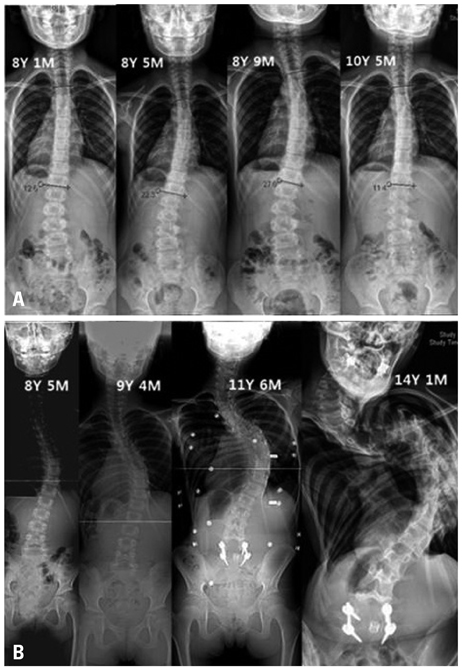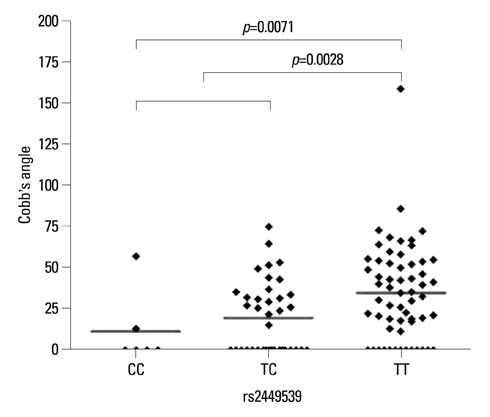Yonsei Med J.
2013 Mar;54(2):500-509. 10.3349/ymj.2013.54.2.500.
Analysis of Single Nucleotide Polymorphism in Adolescent Idiopathic Scoliosis in Korea: For Personalized Treatment
- Affiliations
-
- 1Department of Orthopaedic Surgery, Gangnam Severance Hospital, Yonsei University College of Medicine, Seoul, Korea. hschong76@naver.com
- KMID: 1503917
- DOI: http://doi.org/10.3349/ymj.2013.54.2.500
Abstract
- PURPOSE
The incidence of adolescent idiopathic scoliosis (AIS) has rapidly increased, and with it, physician consultations and expenditures (about one and a half times) in the last 5 years. Recent etiological studies reveal that AIS is a complex genetic disorder that results from the interaction of multiple gene loci and the environment. For personalized treatment of AIS, a tool that can accurately measure the progression of Cobb's angle would be of great use. Gene analysis utilizing single nucleotide polymorphism (SNP) has been developed as a diagnostic tool for use in Caucasians but not Koreans. Therefore, we attempted to reveal AIS-related genes and their relevance in Koreans, exploring the potential use of gene analysis as a diagnostic tool for personalized treatment of AIS therein.
MATERIALS AND METHODS
A total of 68 Korean AIS and 35 age- and sex-matched, healthy adolescents were enrolled in this study and were examined for 10 candidate scoliosis gene SNPs.
RESULTS
This study revealed that the SNPs of rs2449539 in lysosomal-associated transmembrane protein 4 beta (LAPTM4B) and rs5742612 in upstream and insulin-like growth factor 1 (IGF1) were associated with both susceptibility to and curve severity in AIS. The results suggested that both LAPTM4B and IGF1 genes were important in AIS predisposition and progression.
CONCLUSION
Thus, on the basis of this study, if more SNPs or candidate genes are studied in a larger population in Korea, personalized treatment of Korean AIS patients might become a possibility.
MeSH Terms
-
Adolescent
Disease Progression
Female
Genetic Predisposition to Disease
Genotype
Humans
Insulin-Like Growth Factor I/genetics
Korea
Male
Membrane Proteins/genetics
Oncogene Proteins/genetics
*Polymorphism, Single Nucleotide
Scoliosis/*genetics/pathology/radiography
Membrane Proteins
Oncogene Proteins
Insulin-Like Growth Factor I
Figure
Reference
-
1. Weinstein SL, Dolan LA, Cheng JC, Danielsson A, Morcuende JA. Adolescent idiopathic scoliosis. Lancet. 2008. 371:1527–1537.
Article2. Suh SW, Modi HN, Yang JH, Hong JY. Idiopathic scoliosis in Korean schoolchildren: a prospective screening study of over 1 million children. Eur Spine J. 2011. 20:1087–1094.
Article3. Scoliosis is increasing in teenager from 2006 to 2010 in Republic of Korea. Press report in Korea health insurance review and assessment service. accessed on 2011 November 27. Available at: http://www.hira.or.kr/cms/rc/rce_news/1208414_10816.html.4. Renshaw TS. Screening school children for scoliosis. Clin Orthop Relat Res. 1988. (229):26–33.
Article5. Ward K, Ogilvie JW, Singleton MV, Chettier R, Engler G, Nelson LM. Validation of DNA-based prognostic testing to predict spinal curve progression in adolescent idiopathic scoliosis. Spine (Phila Pa 1976). 2010. 35:E1455–E1464.
Article6. Sharma S, Gao X, Londono D, Devroy SE, Mauldin KN, Frankel JT, et al. Genome-wide association studies of adolescent idiopathic scoliosis suggest candidate susceptibility genes. Hum Mol Genet. 2011. 20:1456–1466.
Article7. Katz DE, Herring JA, Browne RH, Kelly DM, Birch JG. Brace wear control of curve progression in adolescent idiopathic scoliosis. J Bone Joint Surg Am. 2010. 92:1343–1352.
Article8. Rahman T, Borkhuu B, Littleton AG, Sample W, Moran E, Campbell S, et al. Electronic monitoring of scoliosis brace wear compliance. J Child Orthop. 2010. 4:343–347.
Article9. Peterson LE, Nachemson AL. Prediction of progression of the curve in girls who have adolescent idiopathic scoliosis of moderate severity. Logistic regression analysis based on data from The Brace Study of the Scoliosis Research Society. J Bone Joint Surg Am. 1995. 77:823–827.
Article10. Kleinerman RA. Cancer risks following diagnostic and therapeutic radiation exposure in children. Pediatr Radiol. 2006. 36:Suppl 2. 121–125.
Article11. Yawn BP, Yawn RA. The estimated cost of school scoliosis screening. Spine (Phila Pa 1976). 2000. 25:2387–2391.
Article12. Wang WJ, Yeung HY, Chu WC, Tang NL, Lee KM, Qiu Y, et al. Top theories for the etiopathogenesis of adolescent idiopathic scoliosis. J Pediatr Orthop. 2011. 31:1 Suppl. S14–S27.
Article13. Ogilvie J. Adolescent idiopathic scoliosis and genetic testing. Curr Opin Pediatr. 2010. 22:67–70.
Article14. Cheng JC, Tang NL, Yeung HY, Miller N. Genetic association of complex traits: using idiopathic scoliosis as an example. Clin Orthop Relat Res. 2007. 462:38–44.15. Mórocz M, Czibula A, Grózer ZB, Szécsényi A, Almos PZ, Raskó I, et al. Association study of BMP4, IL6, Leptin, MMP3, and MTNR1B gene promoter polymorphisms and adolescent idiopathic scoliosis. Spine (Phila Pa 1976). 2011. 36:E123–E130.
Article16. Fei Q, Wu Z, Wang H, Zhou X, Wang N, Ding Y, et al. The association analysis of TBX6 polymorphism with susceptibility to congenital scoliosis in a Chinese Han population. Spine (Phila Pa 1976). 2010. 35:983–988.
Article17. Suh KT, Eun IS, Lee JS. Polymorphism in vitamin D receptor is associated with bone mineral density in patients with adolescent idiopathic scoliosis. Eur Spine J. 2010. 19:1545–1550.
Article18. Siu King Cheung C, Tak Keung Lee W, Kit Tse Y, Ping Tang S, Man Lee K, Guo X, et al. Abnormal peri-pubertal anthropometric measurements and growth pattern in adolescent idiopathic scoliosis: a study of 598 patients. Spine (Phila Pa 1976). 2003. 28:2152–2157.
Article19. Takahashi Y, Matsumoto M, Karasugi T, Watanabe K, Chiba K, Kawakami N, et al. Lack of association between adolescent idiopathic scoliosis and previously reported single nucleotide polymorphisms in MATN1, MTNR1B, TPH1, and IGF1 in a Japanese population. J Orthop Res. 2011. 29:1055–1058.
Article20. Andersen MO, Thomsen K, Kyvik KO. Adolescent idiopathic scoliosis in twins: a population-based survey. Spine (Phila Pa 1976). 2007. 32:927–930.21. Miller NH, Justice CM, Marosy B, Doheny KF, Pugh E, Zhang J, et al. Identification of candidate regions for familial idiopathic scoliosis. Spine (Phila Pa 1976). 2005. 30:1181–1187.
Article22. Gurnett CA, Alaee F, Bowcock A, Kruse L, Lenke LG, Bridwell KH, et al. Genetic linkage localizes an adolescent idiopathic scoliosis and pectus excavatum gene to chromosome 18 q. Spine (Phila Pa 1976). 2009. 34:E94–E100.
Article23. Ward K, Ogilvie J, Argyle V, Nelson L, Meade M, Braun J, et al. Polygenic inheritance of adolescent idiopathic scoliosis: a study of extended families in Utah. Am J Med Genet A. 2010. 152A:1178–1188.
Article24. Barrios C, Cortés S, Pérez-Encinas C, Escrivá MD, Benet I, Burgos J, et al. Anthropometry and body composition profile of girls with nonsurgically treated adolescent idiopathic scoliosis. Spine (Phila Pa 1976). 2011. 36:1470–1477.
Article25. Liu Z, Tam EM, Sun GQ, Lam TP, Zhu ZZ, Sun X, et al. Abnormal leptin bioavailability in adolescent idiopathic scoliosis: an important new finding. Spine (Phila Pa 1976). 2012. 37:599–604.26. Cheng JC, Qin L, Cheung CS, Sher AH, Lee KM, Ng SW, et al. Generalized low areal and volumetric bone mineral density in adolescent idiopathic scoliosis. J Bone Miner Res. 2000. 15:1587–1595.
Article27. Lee WT, Cheung CS, Tse YK, Guo X, Qin L, Lam TP, et al. Association of osteopenia with curve severity in adolescent idiopathic scoliosis: a study of 919 girls. Osteoporos Int. 2005. 16:1924–1932.
Article28. Chen WJ, Qiu Y, Zhu F, Zhu ZZ, Sun X, Liu Z, et al. [Vitamin D receptor gene polymorphisms: no association with low bone mineral density in adolescent idiopathic scoliosis girls]. Zhonghua Wai Ke Za Zhi. 2008. 46:1183–1186.29. Zhou L, He XD, Yu JC, Zhou RL, Shan Y, Rui JA. Overexpression of LAPTM4B-35 attenuates epirubucin-induced apoptosis of gallbladder carcinoma GBC-SD cells. Surgery. 2011. 150:25–31.
Article30. Chen Z, Tang NL, Cao X, Qiao D, Yi L, Cheng JC, et al. Promoter polymorphism of matrilin-1 gene predisposes to adolescent idiopathic scoliosis in a Chinese population. Eur J Hum Genet. 2009. 17:525–532.
Article31. Qiu XS, Tang NL, Yeung HY, Lee KM, Hung VW, Ng BK, et al. Melatonin receptor 1B (MTNR1B) gene polymorphism is associated with the occurrence of adolescent idiopathic scoliosis. Spine (Phila Pa 1976). 2007. 32:1748–1753.
Article
- Full Text Links
- Actions
-
Cited
- CITED
-
- Close
- Share
- Similar articles
-
- Spontaneous Rib Fracture during Boston Brace Treatment for Adolescent Idiopathic Scoliosis
- Etiology of Adolescent Idiopathic Scoliosis: A Literature Review
- The Classification of Idiopathic Scoliosis
- Understanding of single nucleotide polymorphism of human genome
- Is There a Role for Conservative Treatment for Large Curvatures in Patients With Adolescent Idiopathic Scoliosis?: Commentary on “The Effect of Brace Treatment on Large Curves of 40° to 55° in Adolescents With Idiopathic Scoliosis Who Have Avoided Surgery: A Retrospective Cohort Study”



